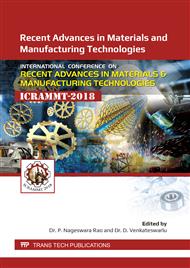p.828
p.834
p.839
p.846
p.852
p.858
p.864
p.870
p.876
Scale down Approach to Solve Distortion Problem in Case of Wind Turbine Tower Fabrication
Abstract:
Submerged arc welding (SAW) process is extensively used in major industrial application such as wind turbine towers and ship building industries for joining of larger thickness (~10 to 50mm) of similar and dissimilar materials. However, other joining processes are not popular to weld larger thickness compared to SAW. In welding, one of the major problems is distortion, which destroys the dimensional stability of the component, a major concern in manufacturing. Simulation of larger thickness component will increase the simulation time. Therefore, an attempt has been made to evaluate a 3 - dimensional finite element analysis (FEA) using SYSWELD to study the effect of the joining of two similar shells of High Strength Low Alloy (HSLA) steel through scale down model in the ratio of 10:1. To reduce the simulation time, the two shells of steel having 400mm diameter and 2mm thickness are modelled and simulated with single pass GMAW process using eight different welding sequences as per welding procedure specification (WPS) using SYSWELD. Results show the simulated welding sequence no. 4 has a considerable amount of reduction in distortion of 1.526 mm compared to that of other sequences. Welding sequence no. 4 is then followed by actual windmill tower fabrication, which resulted in reduced distortion level of 5 mm.
Info:
Periodical:
Pages:
852-857
Citation:
Online since:
August 2019
Authors:
Price:
Сopyright:
© 2019 Trans Tech Publications Ltd. All Rights Reserved
Share:
Citation:


